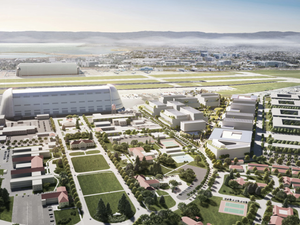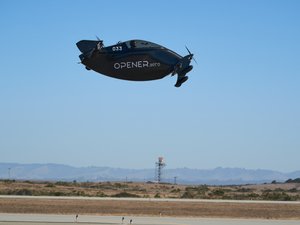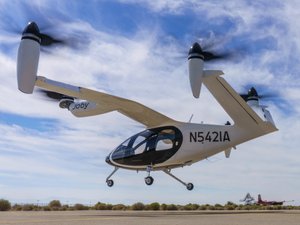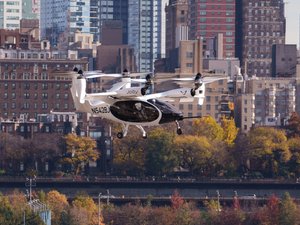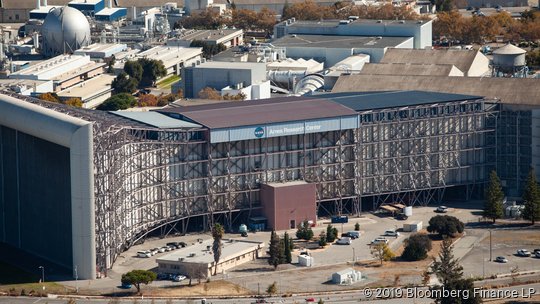
As air taxis and electric vertical takeoff and landing (eVTOL) aircraft seek to make their way in the airspace, two Bay Area organizations are hoping their research can provide guidance to regulators.
Mountain View-based NASA Ames Research Center and Santa Cruz Joby Aviation Inc. said that through a partnership both organization’s researchers are looking at ways of advancing the integration of next-generation aircraft into airports.
"There are so many barriers for (urban air mobility aircraft) to enter into their space but the focus of my team has been integrating them into the national airspace," said Savvy Verma, a lead airspace engineer heading urban air mobility research, in an interview with the Business Journal. "That involves trying to understand how we design the space in such a way that minimizes the impact on the current infrastructure, on the current (air traffic control) workload on whatever the users are using today."
Both sets of researchers have been working together since 2018, but it wasn’t until late last month that a series of simulations were conducted to show how current ATC procedures and tools could be used to integrate the first wave of air taxis across U.S. airports. Representatives from the Federal Aviation Administration, the National Association of Air Traffic Controllers and other industry leaders were at Ames’ air traffic control simulation facility, called the FutureFlight Central, to witness the simulations that were remotely monitored at the facility but held at Dallas-Fort Worth International Airport and Dallas Love Field Airport.
Simulations collected live flight data, tested various weather conditions, and demonstrated to visitors how eVTOL pilots can communicate with air traffic controllers. According to both organizations, the goal of these simulations is to find ways to safely integrate eVTOL operations and reduce workloads for air traffic controllers.
"The biggest challenge is that airports are already saturated," Verma said. "The workload of the controller is pretty maxed out. To some extent their primary responsibility is to manage at the arrivals and departures of traditional traffic. They're not looking at four seaters and five seaters coming in, that's not their primary role. Airports have to worry about ... 'How can I fly this?'"
In initial findings, NASA talked about with the Business Journal, researchers noted that workload for ATC workers will go up because current routes in place at airports are meant to be “high temp.” It’s something Verma said will have to be discussed with regulators.
"We were stressing the system," she said. "If we were to reduce some of the regular communications required to enter into a corridor, enter into a class bravo, get every clearance and sort of do it in a digital way and have the operator and pilot be responsible for some of those actions instead of ATC, it's going to have a huge impact on workload."
In-depth findings from the first round of simulations will be available later this year and shared with the FAA, airports and commercial partners.
Additionally, Verma said NASA will be looking at partnering with other UAM companies to host other demonstrations and to collaborate on research.
Joby did not respond to the Business Journal’s request for comment.
Although simulations are taking place, Verma said it's too soon to tell when there will be mass integration of next-generation air travel at airports or cities.
"It totally depends on if they get certified from the FAA," she said. "When you need more infrastructure and when (companies) want to scale, that is what will take time."
At an industry conference three months ago, experts said that the industry and regulators will have to contend with finding suitable locations for vertiports, the take-off and landing facilities eVTOLs. Those may be easier to site in some locales than others.
San Francisco, for example, has 1,392 suitable locations to place such facilities, according to a joint study earlier this year from Caltrans and the San Jose State University Mineta Transportation Institute. By contrast, the study, which considered a variety of factors, including safety, access to other modes of transportation and the impact of such facilities on disadvantaged groups, only identified 43 suitable sites in San Jose.
And with a growing number of companies looking to offer services within the next couple of years, cities aren't ready. Bay Area companies Joby and San Jose-based Archer Aviation (Nasdaq: NYSE) have said they both plan to begin offering commercial service in 2025.
With NASA Ames and the adjoining Moffett Field being a historic site for aviation, research possibilities have been growing to address those concerns.
Last October, a joint venture between University of California, Berkeley, NASA’s Ames Research Center and San Francisco developer SKS Partners announced plans Monday to begin construction on a 1.4 million-square-foot research and education campus at Moffett Field. The focus of the project, dubbed the Berkeley Space Center, will be research and innovation in the aviation and aerospace sectors.
With growth in the area Verma said other flight demonstration plans are in the work to help guide regulators. However, another demonstration might not take place for one to two years, the planning time needed.
